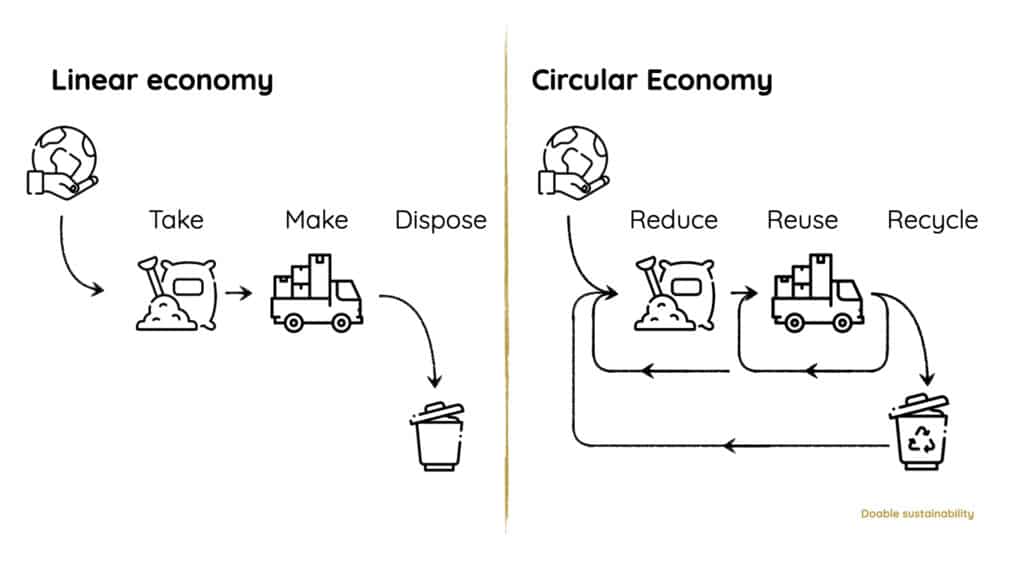This term, which may seem new to some, was already debated in the 1970s. It is a concept that has gained more strength over time due to successive economic crises, environmental crises, price volatility and instability, and scarcity of primary resources.
Okay, but what is the circular economy?
The circular economy is a new economic model that proposes to keep materials, products and their components in circular processes, incorporating them into the value chain once their useful life is over.
It arises as an alternative to the current linear economic model of “take-make-dispose” and the problems that it presents, what to do with waste once the useful life of the product is over? How to obtain “cheap” resources in a constant way? These are some of the questions that arise.The linear model poses a permanent economic growth, ergo, a constant consumption.
However, in a world with finite resources, the concept of infinite growth and when growth depends on limited resources, seems incongruous. At this point, the circular economy proposes to rethink production models using, if possible, biomimicry as a proposal. If there is no waste in nature, why don’t we do the same? That is, be more effective than efficient, any waste can become a resource.

Source: Own elaboration – Doable sustainability
As its name indicates, the circular economy proposes a cyclical system whose fields of action would be to extract, transform, distribute, use and recover materials and energy from products and services.
- Extract: refers to the way in which companies take resources from their environment. They must try to do this more efficiently and responsibly.
- Transform: to ensure that the transformation of the resources extracted is as sustainable as possible.
- Distribute: the environmental impact generated by the delivery of the product to the customer must be reduced.
- Use: aims to reduce the impact of energy associated with the use of the product or the efficiency of the product itself. For example, by repairing, giving a second use to the product.
- Recover: waste must be recovered. This can be done in two ways: biological (the resource can be returned to the biosphere) or technical (incorporating it into the production chain)

Source: Own elaboration – Doable sustainability
The scope of application of the circular economy can be seen at three levels of integration:
- Micro or individual: companies and individuals must make use of clean energy, use of good practices for the environment, energy efficiency, implementation of eco-designs, reduction of carbon footprint, etc.
- Meso: collaborative economy where organizations cooperate to reduce waste, share resources, etc.
- Macro: at a regional or national level where policies for the implementation of eco-cities are established.

Source: Own elaboration – Doable sustainability
The following are examples of the application of this model:
Companies:
- Philips: is a Dutch lighting company. In 2012 it decided to implement the model by offering its customers, as if it were a leasing agreement, to pay for the light, not for the appliance. Once the contract ends, the device is returned for recycling or reuse.
- Natura: considered the 15th most sustainable company in the world according to the Canadian Corporate Knights, it is known for its numerous policies related to reducing carbon emissions, water consumption, solid waste, innovation capacity, salaries, work safety, percentage of women in management, among others.
- Levis: the American company is focused on generating clothing with great durability while minimizing its environmental impact, for which it communicated a strategy in 2009 to reduce energy consumption and efficient water use. Sharing its data with its competitors, last year they held a conference with the aim of obtaining greater knowledge and better practices in water saving.

Photos by Finding Dan, Brandon Nelson, Darth Lui y Felix Fuchs (Unsplash)
Cities:
- Copenhagen: one of the greenest cities in the world, was awarded in 2017 by the C40 Cities Awards as the greenest city for the C40 Cities project as the greenest city for the zero carbon emissions project and totally potable water with a target of 2025. With comprehensive planning, the city now uses green energy, green roofs, sustainable mobility.
- Singapore: in August 2019 it presented a zero waste plan, as well as a model of a circular economy explained in 3 phases and applying the concept “Product as a Service” for the products generated there.
- San Francisco: this is the greenest city in the United States and the application of the circular economy has enabled the city’s environmental and habitability parameters to be improved. It has managed to considerably reduce its C02 emissions into the atmosphere by reducing the number of personal trips within the city by 50% and by promoting the use of public transport powered by renewable energies. The waste collection and treatment plan is inclusive of households and companies, with 0% of waste going to landfill or incineration.
- Cape Town: With the Integrated Waste Exchange Scheme in Cape Town, it has been possible to connect people, public bodies and companies who want to exchange their waste. This project encourages a circular flow of materials and promotes horizontal exchange. Users reduce energy consumption, save money and reduce waste.
References & Resources
- Ellen Mcarthur Foundation, “Towards the circular economy: Economic and business rationale for an accelerated transition”
- Researchgate, (November 2017), “Circular economy: Relationship with the evolution of the concept of sustainability and strategies for its implementation”
- Associació Pacte Industrial de la Regió Metropolitana de Barcelona (Februar 2018), “Qué es la economía circular y por qué es importante para el territorio“
- Flaticon
- Unplash – Findin Dan, Brandon Nelson, Darth Lui and Felix Fuchs




Comments
Pingback: Solving the Cradle to Cradle puzzle - Doable Sustainability
Like!! Great article post.Really thank you! Really Cool.
Author
Glad you like it!
Wow, fantastic weblog layout! How long have you
ever been running a blog for? you make running a blog look easy.
The total glance of your site is wonderful, as neatly
as the content material!
Author
Thank you very much for your encouragement, your words and for writing to me. It encourages me to keep going.
Kind regards.
파라오카지노
It is actually a nice and useful piece of information. I’m satisfied that you just shared this helpful information with us.
Please stay us informed like this. Thank you
for sharing.
Fantastic post however I was wanting to know if you could write a litte more on this subject?
I’d be very grateful if you could elaborate a little bit further.
Kudos!
Author
Yes, sure!! Thanks for your interest on it!
optimal content, i like it
wonderful article
Author
Thanks Dudley!
best article, i like it
super article
Author
thanks!
Hi there to all, since I am genuinely eager of
reading this website’s post to be updated regularly.
It contains nice stuff.
Fortunately, there is a new AI bot that can write the content fo website, and it’s fully optimized to increase your ranking as well.
You can see the magic of AI in a video here =>> https://zeep.ly/zePEY
Author
Hi Barbara,
as long as I learn by researching the topics that interest me and write about it, it’s worth it. I learn, maybe someone else will too by reading it. This blog is not to compete with AI, it is to learn and generate a space for constructive debate.
Kind regards
María